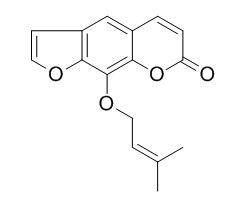Natural Products
Imperatorin
| Catalog No. | CFN98758 |  |
| CAS No. | 482-44-0 | |
| Molecular Weight: | 270.3 | |
| Molecular Formula | C16H14O4 | |
| DBs | [PubChem]:274951746 [ChEMBL]:5885 [PCIDB]:2477 |
Standard InChI:
InChI=1S/C16H14O4/c1-10(2)5-7-19-16-14-12(6-8-18-14)9-11-3-4-13(17)20-15(11)16/h3-6,8-9H,7H2,1-2H3
Biological Activity
Imperatorin, a biologically active furanocoumarin from the roots of Angelica dahurica (Umbelliferae), can induce apoptosis in human promyelocytic leukaemia, HL-60 cells,
and induces apoptosis was significantly blocked by Z-VAD-FMK (a broad spectrum caspase inhibitor), Z-LEHD-FMK (a caspase-9 inhibitor) and Ac-DMQD-CHO (a caspase-3 inhibitor), but not by Z-IEDT-FMK (a caspase-8 inhibitor).[1]
Imperatorin and quercetin are potent apoptosis inducers, especially when they act synergistically, which may be a promising combination useful in glioma therapy, it also blocks the HSP27 and HSP72 gene expression might serve as a therapeutic target for the human brain cancer.[2]
Imperatorin has been used in herbal formulations for the treatment of hypertension and cardiovascular diseases, it exerts considerable anti‑proliferative activities in HT‑29 colon cancer cells and highlight the potential of imperatorin as an anticancer agent for colon cancer.[3]
Imperatorin exerts anti-inflammatory activity, also has effects on inhibition of degranulation and eicosanoid generation through the suppression of multiple steps of IgE/Ag-mediated signaling pathways would be beneficial for the prevention of allergic inflammation.[4]
Imperatorin has anticonvulsant effects, dampens neuronal excitability by inhibiting voltage-gated Na + channels (VGSC).[5]
Product
References
[1] Pae H O, Oh H, Yun Y G, et al. Pharm Toxicol, 2002, 91(1):40–48.
[2] Wu K C, Chen Y H, Cheng K S, et al. Eur J Pharmacol, 2013, 721(1–3):49-55.
[3] Zheng Y M, Lu A X, Shen J Z, et al. Oncol Rep, 2016.
[4] D Bądziul, Jakubowicz-Gil J, Langner E, et al. Pharmacol Rep , 2014, 66(2):292-300.
[5] Jeong K T, Lee E, Park N Y, et al. Biomol Ther, 2015, 23(5):421-7.
[6] Xue J, Ping W, Yang W, et al. Chemistry & Industry of Forest Products, 2008, 28(3):101-3.
Product Use Citation





